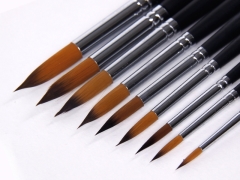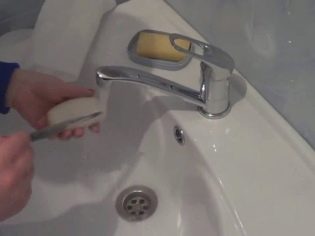Brushes for acrylic paints: features of choice
Any professional artist will say that to create a real masterpiece it is very important to carefully choose not only paints, but also canvas, and even a workplace with the right lighting, and the main tool for work — brushes — must be chosen carefully.
The numerous variety of brushes that can be observed on the modern market is caused not only by the difference in the availability of raw materials for manufacturers and consumer capabilities of the population, but also by the variety of techniques and colors that each person of art chooses according to his own taste. Everyone decides for himself which brushes for acrylic paints are better; however, there are also such brushes that are not at all suitable for painting with acrylics.
Material
When choosing a brush for any kind of paint, it is important that the tool lies well in the hand of the artist, being like its continuation, and at the same time has a certain strength that will save it with prolonged or careless use. For greater durability advised to choose those brushes that are equipped with a solid metal cage - there are no chances that it will eventually accelerate.
If the material of the handle depends only on the convenience of the artist himself, then the material of the hair bundle is crucial for obtaining the expected result. In particular, most artists generally prefer natural hair brushes, however, they are not used when working with acrylic-based paints. The fact is that the polymer part of the dye, very quickly hardening at the base of the hair bundle, in the shortest time leads the product into disrepair, because of which it becomes impossible for them to draw.
A possible solution to the problem could be the permanent presence of the hair bundle in the water, however, and such conditions are destructive for natural hair.
Most experts agree that aspiring artists working with acrylic need, first of all, synthetic brushes, in particular, nylon brushes. They are much less susceptible to the harmful effects of acrylic, which, while freezing, causes individual hairs to lose elasticity, but you need to work with them carefully, in particular, be sure to thoroughly wash after each drawing session.
With proper care, such a tool can serve its owner for a long time, but by professionals it is still not considered a universal means for drawing. To expand the number of artistic techniques used for painting, most often used brushes based on natural bristles.
Why nylon?
Although in the arsenal of the artist, who has long and fruitfully painted with acrylic, there will certainly be brushes from other materials, newcomers are almost always advised to use nylon first. It makes sense to understand why this particular material, and not any other:
- High elasticity and resilience. It should be noted that nylon brushes are usually considered an average option between hard and soft brushes, therefore, they are regarded as universal and such that they are well suited for any novice artists, and not only for those that paint with acrylic paints.
- Due to these properties, the hair bundle leaves clear and smooth strokes on the canvas, while the material withstands multiple flexing quite well and does not break, which is very appropriate in the case when the owner still has not decided on the optimum pressing force.
It is noted that it is much easier to paint with brushes of this type in principle, although they do not leave much space for artistic maneuver.
- High water resistance. The specificity of protecting the hair part of the brush from the harmful effects of fast-curing acrylic lies in the active use of water, and synthetic materials, unlike natural hair, are much better tolerated by the constant stay under water. Since without regular rinsing the hair bundle will quickly become unusable, the ability to stay in water for a long time is key to tools for working with acrylic.
- Ease of maintenance. No matter how optimized the use of acrylic is nylon, the polymer part of the paint still sticks to it, however, here the synthetic brush has a clear advantage, namely: the smoothness of its bristles. Natural hair bristles have a certain roughness, because of what to clean them from pieces of frozen acrylic is quite difficult. In the case of nylon, acrylic can harden, but this happens on the surface of the bristles without a reliable bond with them, so it is enough just to rinse the instrument well, so that it is again suitable for work.
The choice of shape and stiffness
The choice in favor of nylon as the material of the hair bundle does not mean that the final verdict has been passed - after all, you need to choose at least a few tools in order to achieve various artistic effects. For this preference is given to brushes of different shapes and elasticities:
- The most universal choice in terms of shape is a round brush, but because of its versatility, it does not allow any effect to be performed as accurately as possible.
- Brushes with flat hair bunches create for more convenient painting of large monochromatic areas.
- Contour brushes are somewhat similar to them, but their beam width is much smaller, so artists often use them to draw color transitions.
- A tricky tool is a cat-shaped brush - a wide, but with a very pointed end, which makes it both round and flat, but for a beginner to fully work with it usually turns out to be too difficult.
- Finally, linear brushes differ in nap of increased length and are used, as a rule, for writing calligraphic texts.
- As for elasticity, here the tools differ, depending on the needs. Soft pile is better suited for accurate, fine drawing of contours and other small parts. Rigid products are chosen more frequently for embossed design, as well as for applying large, greasy smears.
It should be noted that differences are also observed in the size of the pile. Each manufacturer specifies the size in the form of a number from 1 to 14-16, however, practice shows that different manufacturers of the same brush number can correspond to a different actual size of the hair bundle.
For this reason, the choice of tool size should be not so much by number, but by eye.
Care
Even the constant holding of brushes in water when working with acrylic does not guarantee one hundred percent cleanliness of the hair bundle after the end of the session, and if the paint dries out completely, the tool can be safely thrown away. Therefore, every time after use it is necessary to clean the product, even if it is made of nylon:
- First of all, the pile must be carefully wiped with a special cloth or at least a piece of thick paper.
- After that, the hair bundle promakivaetsya in clean water - the tool must be rotated several times to make sure that water has penetrated everywhere.
- Wet hairs are again wiped with a dry cloth, and then soaped with ordinary soap so that it gets even under the clip and again carefully washed, now under running water.
- A brush is considered washed only when the water flowing from it looks completely transparent.
- After that, the pile must be dried naturally, but before that it must be wiped dry. It is necessary to give the hair bundle the correct shape for it, because if it dries in disheveled form, then the situation will be quite difficult to correct.
On how to clean the brush, if they are dry after writing a picture, see the following video.



































